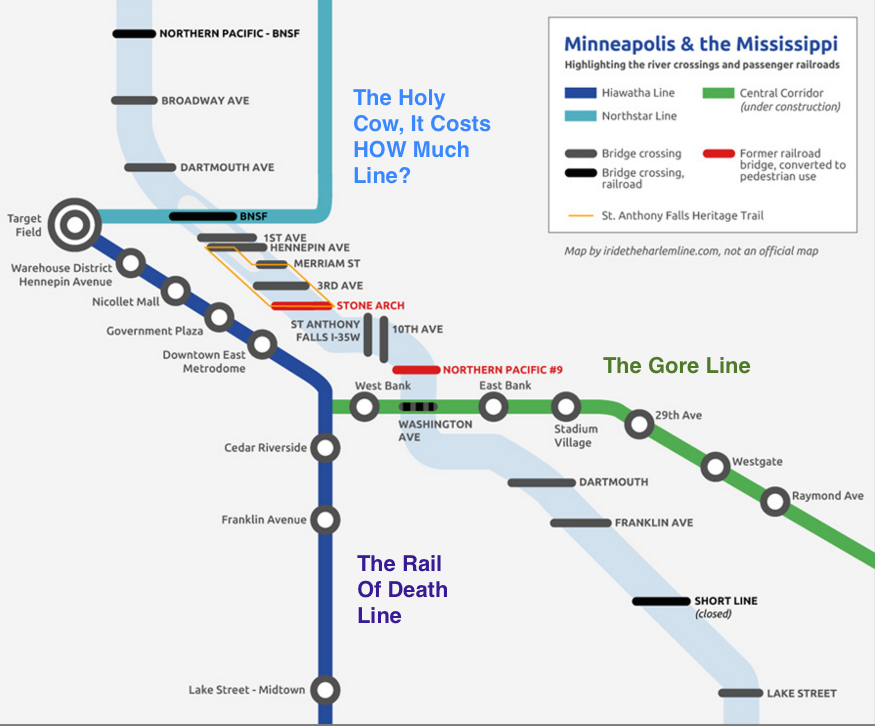Yet another pedestrian has been killed along the Rail Of Death Line from downtown Minneapolis to the Airport. I’ll urge prayers for his family and the people in his life.

Map borrowed from “iridetheharlemline.com”. I do not ride the Harlem line, but it’s one of the better maps of the TC rail system I’ve seen…
This follows on two more train-pedestrian accidents on the Rail of Death Line, as well as the Gore Line through Saint Paul, last month.
If It Saves Even One Life…:That brings death totals to:
- Twelve dead on the Blue Line of Death in a little over ten years.
- Three dead on the Gore Line in about 18 months.
- And – I didn’t know this at all – four deaths on the Northstar.
That’s more deaths than in every spree killing in Minnesota history – and we’re paying for it.
Minnesota doesn’t need any spree killers, Kim Norton. We have our transit system.

I’ve always maintained there’s nothing wrong with the Hiawatha Line that couldn’t be cured with a well-coordinated A-10 strafing.
Notice that every time there’s an “incident” with LRT, they mobilize the buses to pick up passengers? Here’s a thought: rip out the rails, pave over the bed and make buses run the route. It’ll be MUCH cheaper and much less fatal.
OK, back of the envelope estimate here, but they say that about ten million rides per year on the Hiawatha, don’t know about the others, but twelve deaths among 120 million rides of an average of 8 miles or so is about the same death rate as you’d have in cars–somewhere between 10-20 deaths per billion passenger miles. If I estimate about 5% of commutes for the population as a whole (5e10 miles), plus about 4000 miles/child for 50 million school children (2e11 miles), you’re getting about 1.5 deaths per billion passenger miles on buses.
In other words, buses are not only an order of magnitude cheaper than Death Trains, but are also an order of magnitude safer. One might infer that using a “bearing” (steel on steel, possibly wet) as a brake and using a carriage that weighs ten times as much as a bus might impact braking distance and safety.
Bubba: You do math, too? You, sir, are a Renaissance man.
Stinky; someone’s got to do it, and it sure ain’t the Metropolitan Council, the Governor, or transit officials. :^)
Interesting story about Chicago’s trains. About 700,000 riders per day versus the 50k or so here in the Twin Cities, but about 10x more fatalities per year. So even separating the trains from the streets doesn’t seem to do that much to reduce fatalities. Along the same lines, about 50 people die each year in New York City’s subways.
http://articles.redeyechicago.com/2012-04-30/news/31502481_1_rail-deaths-cta-station-cta-spokesman-brian-steele
https://en.wikipedia.org/wiki/Chicago_%22L%22
Aren’t the ride numbers on the Hiawatha skewed by the non-revenue passengers transiting between Humphrey and Lindbergh terminals at the airport?
I’ve never looked into it but I have wondered since moving here if the airport council was forced to incorporate the Hiawatha Line as transfer between terminals for the sole purpose of inflating LRT passenger numbers.
San Juan,
Could be.
Same as the Green Line’s free-ride to students between the various U of M stops.
Looking at the map I notice that Dartmouth Avenue crosses the river twice? Rather a strange street naming system.
The only advantage light rail has over buses is greater efficiency when ride load is very heavy.
Unless you are an urban planner. Then LR gives you control over how other people live their lives. Where they live, shop, and work. All under the control of some moron with a BA in Urban Planning. And the capitalists, of course, who are much smarter and much more motivated than the morons with BA’s in Urban Planning.
When these wacky plans for LR are suggested, look at history, not at projections.
History will show that the cost of LR is always higher than projected, and cost per passenger mile is always higher than projected.
Riddle me this: How do you know when the Met Council is lying about light rail ridership numbers?
A: If they open their mouths during the legislative session.
Ch 5 news story on the death last night, they interviewed some people who couldn’t understand how people could miss the train coming, what with all the noise and bells and whistles.
I couldn’t help noticing one of the interviewees had a pair of over the ears headphones around his neck.
Headphones, yes–it was a proverb when I was running cross country that you could tell who wasn’t serious about running by clean shoes and headphones. Still should be.
Another possibility; many suggest the deaths from the El and the NY Subway are significantly suicides. Lot of rail history about engineers and firemen quitting after the nth horrific death on the front of their locomotive that way.
Bento; I’d have to guess that the efficiency improvement isn’t that great, seeing that the weight of the carriage per passenger is so much greater. But as you note, no biggie when you realize it’s empty most of the time. Even the Hiawatha Line–which avoids most of the big issues of being empty due to commuting patterns (as it runs from downtown to the airport and zoo)–is running at 30% of capacity, if I’m calculating correctly ( six trains of 200 capacity per hour). Oops.